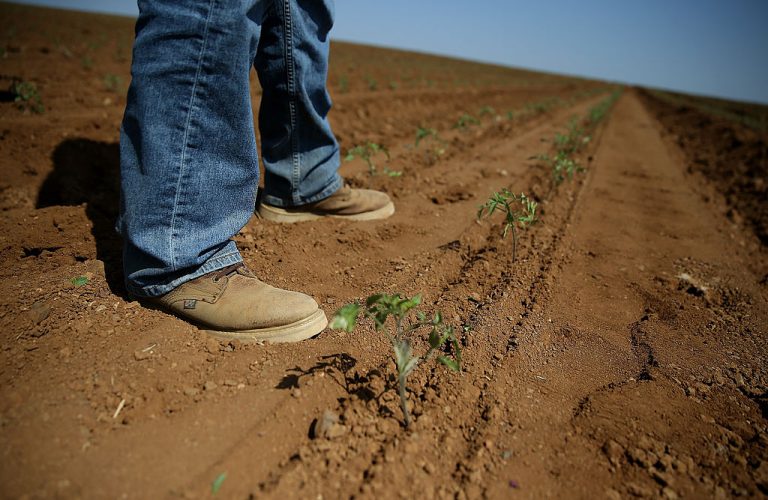Drought is ravaging mankind’s 2022 harvests, with everything from rice fields in global export leader India to potatoes in American production cornerstone Idaho being severely impacted.
But now, some areas of California are experiencing escalating prices of critical restaurant components — such as tomato sauce, tomato paste, and ketchup — because drought has demolished the state’s crops.
California Tomato Growers Association chief Mike Montna bluntly told Bloomberg for an Aug. 13 article, “We desperately need rain.”
MORE ON THE EXISTENTIAL THREAT OF DROUGHT
- This Year’s Droughts Are Crushing the US Cotton Industry
- Toyota’s Chinese Factory Shutters Because of Drought-induced Electricity Shortage
- Rhine River Just 1.5 Feet Deep in Some Areas as Heatwave Scours Europe
- US Cattle Herd Hits 6-Year Low as Breeding Stock Sent for Slaughter
“We are getting to a point where we don’t have inventory left to keep fulfilling the market demand,” he added.
The situation in California is dire, as the drought-rooted water crisis has left more than 800,000 acres, roughly 1,250 miles, of farmland left untended this year, a figure double that of last year and the most idled land in decades, according to preliminary findings by a University of California Merced researcher issued in July.
Success
You are now signed up for our newsletter
Success
Check your email to complete sign up
The data is exceptionally significant as most of the new dustbowl is seated in the Central Valley region, which is normally responsible for a quarter of America’s food production.
Bloomberg explained that the California tomato plantation is likewise responsible for a quarter of global tomato production.
The circumstances have led to a rise in cost of tomato-based foodstuffs critical to restaurants so severe that it’s outpacing U.S. food inflation, which is already at its highest figure in 43 years, Bloomberg said.
Rick Blankenship, VP of Farming Operations of Woolf Farming, told the outlet that the problem isn’t just drought, but rising costs of fertilizer and fuel have also led to a situation where the cost of harvesting an acre of tomatoes now costs $4,800, compared to only $2,400 10 years ago.
A similar plight was lamented by the Idaho potato industry in a June 15 article in industry magazine Spudman, where a report by the Idaho Grower Shippers Association found that the cost of packaging alone had skyrocketed by 36 percent over the course of just the last two years.
Spudman further said the report also found that, “The cost of labor went up 28%, the cost of repairs rose 17%, the cost of chemicals increased 48% and the cost of scooping and hauling potatoes from storage rose 31%.”
Blankenship told Bloomberg that tomato yields were already “way off this year,” adding, “Coupled with drought, we’ve had high temperatures and that in itself creates an issue where the tomatoes are so hot that they just don’t size properly — so you have a lot of tomatoes on a plant, but they are smaller.”
This pain was experienced in Canada last year after a record-setting heat wave caused by a curious high pressure heat dome that saw British Columbia become temporarily hotter than the record temperatures ever posted in Las Vegas ruined fruit crops and left local shellfish populations to boil alive and rot on the shoreline.
President of the BC Fruit Growers Association, Pinder Dhaliwal, told state-funded messaging outlet the Canadian Broadcasting Corporation in an interview at the time that because the heat was so extreme, coupled with no cooling at night, that the cherry crop simply cooked on the trees to such an extent that even the pits were hot to the touch when examined by growers.
Blankenship further told Bloomberg that although California’s tomato growers were earning an all time high for this year’s crops — $105 a ton — it may not be enough.
“You would think that it was a home run for growers, but in reality the input costs have gone up so much that the potential profit was all gobbled up,” he added.
Another area farmer that normally produces rice told Bloomberg that they slashed their rice crop by 90 percent this year, sewing tomatoes instead, in an attempt to get the best bang for their buck amid the state’s water crisis.
The farmer told Bloomberg that because of heat, drought, and an unfortunate mid-April frost, that unfortunately, yields “so far are below average.”
A representative for Ingomar Packing Co., described by Bloomberg as one of the world’s largest tomato packers, stated that because “the water is either too expensive or just not available at any cost,” that “there are simply not enough acres of processing tomatoes being planted this year to ensure that everybody gets their full supply.”
















